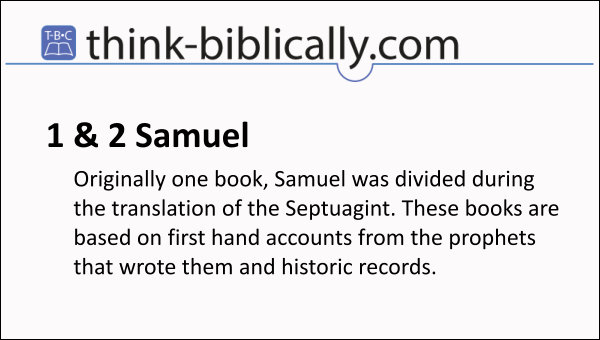By Tyson Thorne

Originally one book, Samuel was divided during the translation of the Septuagint. It records a lengthy history; from the time of Eli, the high priest of Israel (1 Samuel 1) around 1150 BC, to the end of the reign of David in 1004 BC. (2 Samuel 24) we're looking at a time period of about 150 years. A lot of history happens during this century and a half, including the transition of Israel from a theocracy to a united monarchy. These books are based on first hand accounts from the prophets that wrote them as well as history from historic records.
1 Samuel covers the birth of Samuel to the death of Saul, a period of around 90 years. This first book teaches that a king is not autonomous in his ability to rule and is instead an instrument of God's reign. For this reason we see Saul, Israel's first king, deposed due to his inability to obey God completely.
2 Samuel covers about 60 more years, give or take, and largely cover's King Davids reign and introduces the Davidic covenant — a promise fulfilled in Jesus. David conquered most of the land God promised to Israel and Jerusalem became the capitol city. After making Jerusalem the political capitol, he had the Tabernacle brought there to make it the spiritual capitol as well.
Author and Date of Writing
The time period recorded in these two books is far longer than one author could have witnessed. The Jewish Talmud instructs us that the first part of this work, 1 Samuel 1-24, was written by the prophet himself while the rest, 1 Samuel 25 through 2 Samuel 24, were written by the prophets Nathan and Gad. There is no reason to believe otherwise, especially as 1 Chronicles 29.29 seems to back this up. With the time line and these authors in view we can affix an approximate date of 975 BC as the date of completion for 1 and 2 Samuel.
Big Idea
Human leadership has benefits and dangers, and regardless of how the tide turns they are not the most powerful force in our lives — God rules completely.